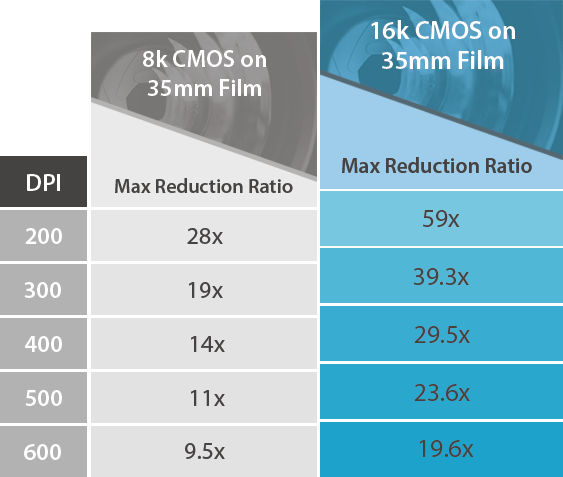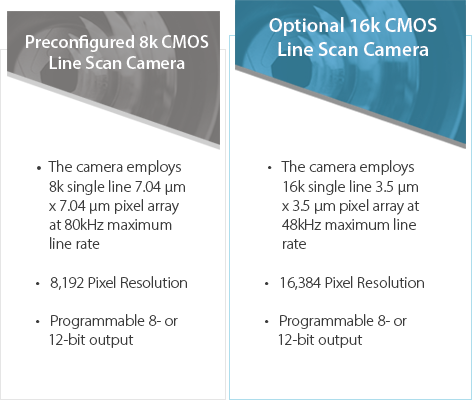Microfilm archives typically contain unique historic data that can’t be found anywhere else. That means that converting it to digital records must be done in a way that ensures not only that the images are readable but that all the data on the film has been captured and not accidentally omitted. In this article we explore how we create images that are unmatched for image quality.
nextScan’s microfilm scanning solutions deliver enhanced and powerful scanning capabilities to consumers through our advanced optics, state-of-the-art line scanning camera, and our NextStar software. Our typical microform conversion scanners are built with an 8k line scan camera, one of the most advanced CMOS sensors on the market that delivers high quantum efficiency and low noise for crisper and cleaner images. Optionally, nextScan now offers a custom 16k configuration for users who need to reach even higher image resolutions.
What a 16k Line Scan Configuration Means for End Users
nextScan uses Line scan cameras to capture a roll of film from end to end and side to side. This ensures that 100% of the data or images on the film are captured. This method of scanning has the capability of forming a continuous image that is not limited to a specific vertical resolution. This allows the scanner to output images with higher resolutions, in turn yielding crisper and cleaner results for the end user.
In combination with our advanced optics and proprietary LuminTec lighting technology the 16k line scan camera is creating endless possibilities for institutions seeking superior image quality in large production scanning environments.
End Users with a 16k configuration can benefit from:
• Full film and image capture, end to end, edge to edge
• Full range resolution due to lighting and capture technology
• Clearer images due to our Stroboscopic Lumintec light source
• Greater capabilities for image enhancements during the auditing phase of conversion
End Users now have a greater range available between max reduction ratios and DPI that can be achieved with the 16k camera on 35mm and 16mm film. Below we list a comparison of capabilities between the 8k and 16k configuration on 35mm film:

Specifications: 8k vs. 16k

Calculating DPI with a 16k Configuration
nextScan’s advanced optics and lighting in combination with a 16k line scan camera enables scanning at all available resolutions that light allows. The 16K camera allows image output resolution to reach up to 30,000 Dots Per Inch (DPI).
According to nextScan’s Vice President of Engineering, Kurt Breish, from a practical and theoretical stand point, white light will allow end users to scan down to approximately 1 μm (micron) pixel size, or 25,400 DPI on 16mm film. The minimum for nextScan’s FlexScan multi-format scanner is approximately 3,600 DPI on the film. However, the image can be scaled down by increments of 2x, 4x, etc. using a technique called “binning”, so the lower end of on-film DPI is really ZERO DPI. As a result, nextScan’s high production microform conversion scanners allow customers to output images at nearly any desired image resolution.
16 mm film at 1 μm (micron) pixel size (the limit of light), requires 16,000 pixels, and nextScan’s 16k camera allows for 16,384 pixels. The highest resolution on 16mm film is limited by the physics of light at 25,400 DPI. On 35mm film nextScan scanners can achieve 2.14 μm microns, or the highest resolution 11,869 DPI.
End users can calculate the DPI by dividing the above numbers by the reduction ratio as described in the equations below:
16mm film (limited by light) is 25,400 DPI (1 μm micron pixel size) at 25x reduction ratio is:
25,400/25 = 1,016 DPI on the original
And on 35mm film is 11,869 DPI (2.14 μm micron pixel size) at the standard newspaper reduction of 19x is:
11,869 / 19 = 624 DPI on the original
These above numbers are based on the 16,384-pixel camera. To calculate DPI for our standard configuration (8,192-pixel camera) simply divide the results by 2.
THE Scanning Solution for Archival Functions
Higher resolution requirements are generally dependent on your industry’s sector and the digital imaging requirements for conversion of microforms. Higher resolution standards are commonly utilized for archival functions for entities including archives, museums, libraries, and service bureaus. Many of our clients choose nextScan technology because it meets the demands in the Federal Agencies Digitization Guidelines Initiative (FADGI) in the United States and internationally recognized guidelines set forth by organizations such as the International Federation of Library Associations and Institutions (IFLA).
To inquire more about our scanning solutions, contact sales@nextscan.com or visit our Products page.
